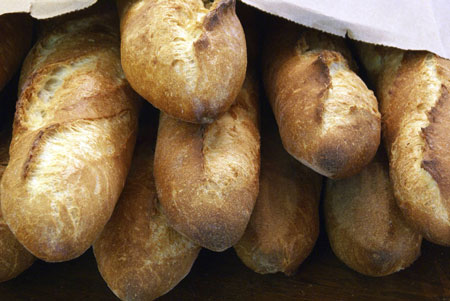
By my count, I’ve made around 100 baguettes in class over the past two weeks. Tomorrow I have practical exam in which I have to mix two doughs and make roughly 15 baguettes from each one. The next day is more practical exam, and that means more baguettes. I am tired at the end of each day, and if I’m being honest, I’m a little tired of baguettes too.
So what did this tired on tired translate into last night? When I got home, did I take a hot bath? Watch a little TV? Catch up on my reading? How about on my sleep? Well, no. I made a few more baguettes. I can’t explain this entirely. It had something to do with wanting to know if I could make a baguette in my own kitchen that looks as good as the ones we’ve been turning out in class.
The answer is no, I couldn’t. Or at least I didn’t (see below photo). However, because I am presumptuous by nature, I will presume to tell you what I know, or I think I know, about scoring the damn things.

- I use a lame (pronounced like llama without the final “a”). It is a double edged razor blade attached to a metal handle so that the blade is curved. This allows you to use just one corner of the blade without having its back end get in your way. I have seen people do an awesome scoring job with a knife, however.
- Hold the blade at an angle to the dough (left), not perpendicular to it (right).
- Cut as straight along the long axis of the loaf as possible. The cuts need to overlap, so they cannot be entirely straight up and down without running them off the side of the baguette, but mentally divide the baguette into lengthwise thirds, and keep the cuts within the middle third. Overlap the cuts by about one third of their length.
- Cut quickly. You can point the cutting edge either toward or away from yourself, but either way, all of your motion should be in the direction the cut is to run. Don’t pull the blade in towards yourself or push it away. Think about getting a paper cut on your finger. The paper barely grazes your skin.
- Good opening of the cuts is determined not only by your scoring technique but also by proper steam and oven heat, the strength of the dough, and how well the baguette has been shaped. I have had some requests to do a baguette-shaping video. I’m sorry, but I’m just not that good at it yet, and I’m not that presumptuous.
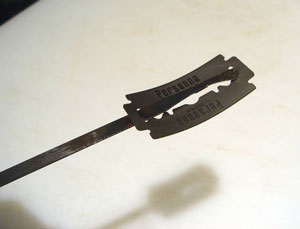
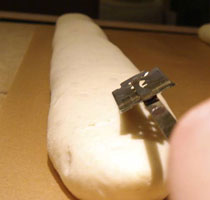
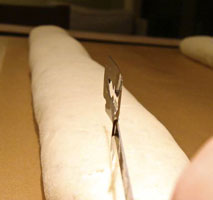

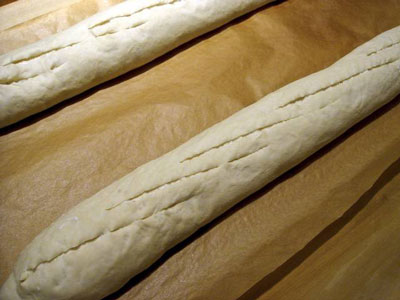
The best of good luck in your practical … what’s next after baguettes?
Joanna
I’ve had issues with my cuts closing during loading as I don’t have a peel and my fumbling attempts at using parchment paper by itself seem to backfire on me.
I love your dedication not only to learning, but also to sharing the knowledge you’ve acquired. So generous!
What is wrong with your baguettes from home? Did the grigne (or whatever it’s called) not open enough? If I had made such lovely loaves I would be more than presemptuous and would start telling the world I’ve mastered baguettes.
As for scoring, thanks for the lesson. I have one of those lames, but sigh, I’ve never been able to get a clean cut with it. If I tried to score my baguette with a hair brush I’d have better results. Maybe your tutorial will inspire me to try again.
Scoring bread is always horror to me. 🙁 I hope with your instruction it will go better.
We’re having all fingers crossed for your practical here, though I am pretty sure you won’t need much luck, after all. You’ll do great.
Imagine in a real bakery how many you will have to produce!!!
I often do the same thing, come home after a twelve hours shift of cooking and bake bread, relaxing, really!
Your lessons on the baguettes are very interesting! I like the details you are showing here. All the very best for your practicals!
I didn’t know that about scoring. Good luck on your practical.
Thank you so much for this little tutorial, Susan. I have the hardest time scoring although I have a lame. I’ll try again using your tips.
I’ve been enjoying all the science behind baguettes! Your comment about a hundred baguettes in two weeks got me thinking: If all the students have that many, you are all probably tired of baguettes, so what is done with all that bread? Is it handed out to the homeless, or a food pantry, or…? The possibility of all that bread being tossed makes me feel very sad.
They look god to me….
Good luck…I am sure you will do fine…
Your instructor’s been doing this for years, full time. For having only two weeks worth of practice, those loaves actually look darned good — much better than any of my students did at this point.
So . . . has the repetitive motion and day-after-day routine — followed by the teacher’s critique — affected your thoughts about artisanal baking as an attractive career option?
Thanks for the informative post! I’ve been using a tomato knife for scoring at home, and while it’s not a lame, it’s getting better. I’ve got a lame on my list of ‘to get’ things. Best of luck on your practical!
Beautiful baguettes. Clearly, practice makes perfect (or better, at least). I just started learning to shape and score them, and I have a long way to go. I’ve thought about enrolling somewhere, just so I have an excuse to make them over and over again until I get the hang.
I bought one of those lames from SFBI, and I’m not sure how best to insert the blade. In your photo, it looks like the end isn’t laced thru it. Did you get pointers on how to use it that you can share?
I think they look pretty good. How many ounces were they and how long?
Slashes are known as la grigne in French (the grin).
You have to make a swift 1/4 inch deep angled cut into the bread (your photo shows the angle beautifully). It is hard to learn unless you have the opportunity to practice on many baguettes at once. I finally got it baking 300 baguettes at a bakery one morning.
I kept scrolling down looking for the less-than-perfect baguettes and didn’t see any. Are you telling me these French bakery quality looking baguettes are not absolutely perfect? Man, Susan, where does that leave the rest of us? They are stunning – and trust me, I know baguettes. Been thinking of you…
Thank you, susan, for your dedication to baking and sharing what you learn. I have not mastered the lame, and prefer single edged razor blades, but I still do a poor job with baguettes. I’ll try again with my lame.
Best of luck with your practicals.
I’d say your home loaves are absolutely beautiful – better than I could do.
Thank you so-o-o-o-o much for the scoring tutorial. I see now one (of the likely zillions) of things I have been doing wrong.
Good luck on the exams
Thanks for teaching me how to score! 😉
I think scoring is the hardest thing for me to get! I suspect I’m proofing too long, which makes scoring harder to do right – but your tips are wonderful – you are a gracious princess.
PS: what do you guys do with all those extra baguettes?
Thanks for the scoring-tutorial! For me, your scoring looks great! Scoring is always the hardest part for me, even with my new lame. I’ll keep my fingers crossed for your exam.
Great scoring tutorial! First time I’ve seen clearly what the books talk about with regard to the overlap and the rule of thirds. All the best always!
Wonderful Susan, so happy that you always share your knowledge. Btw, what did you do with all of those baguettes in your kitchen? I wouldn’t mind to taste a bit…
Beautiful! I recently slashed a gorgeous gringe – the kind that you look at and know it will bloom perfectly in the oven. Sadly it was in my left index finger. I think I am going back to practicing on bread.
Loved this post too….
Good luck on your exam! I look forward to hearing about it… actually, to reading about it
YOU ROCK (and ROLL)!
I must confess that I don’t quite see the difference between the school baguettes and your home baguettes. Both look very very good.
Many thanks for the scoring tutorial. I’m especially appreciative about the overlap section.
Wow – you are in deep! I’m in awe and am so happy that you are sharing what you learn here. Beautiful baguettes!
Susan, what strength of flour were you guys using in class for the baguettes? More of an all purpose type or a bread flour?
You mentioned the baker’s percentages in the last post — trying to get a handle on how wet the dough would be…
marty
You’re tired after 100 baguettes in two weeks?
When I worked at an artisan bakery, I rolled 100 baguettes a night!
Thanks for the ‘map’; I will make my next batch using it as a guide. I use a scalpel held at 45 degrees.
I have used a ‘zipper pattern’ before; it can really be spectacular. Add 3 Tbl of diastolic malt to your recipe… lots of flour dusting prior to the clash for visual effect, then slash like this:
/
\
/
\
… pretty deeply at a high angle, the ‘ear’ is important. A hot bake @ 500° convection for 6 minutes and then 460° non-convect for another 10 to 12 minutes directly on the stone will produce caramelized, magnificent crusts that will disappear in minutes after they’re cool enough…
thanks for all you share and do…
John the Happy Baker
*clash should read “slash”. oops
I took an artisanal bread class @ French Culinary last spring. We made LOADS of baguettes -great for building skills and confidence. At home I find my baguettes deflate quite a bit when I slash them. They rise well in the oven, but I can’t help but wonder if I’m not building enough structure in the dough so that it would maintain some shape after slashing. I use a Kitchenaid Pro 600 Stand Mixer (my new toy) with dough spiral and it seems to take long to windowpane….or am I somehow bypassing a small window of time where the dough would windowpane? Would appreciate input/advice!
I am trying to perfect the baguette, however they don’t seem to bake rounded in the oven, I score them the way they are supposed to I think, my dough looks like yours in the pic, but they bake up rounded at top, but a bit flat at the bottom. what can i be doing wrong?
Nina B I took the same class this spring, but my baguettes dont come out like the ones we made at the FCI… I also use the same mixer like you do. I have found that the water is a bit too much, so I cut down on the water. It windowopanes good enough, but my baguettes dont bake as rounded as the FCI ones do.